The case of the Polish Rxb2
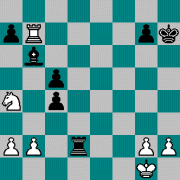
Black to play 'Ortueta - Sanz' Madrid 1933 |
The key move of the combination (if you know there is one) may be obvious: 1...Rxb2!! Sanz, a one-time champion of Spain (1943), and 25 years old at the time, found the move that made him immortal after some forty-five minutes of calculating. 2.Nxb2 c3 3.Rxb6 (or 3.Nd3 c4+ 4.Rxb6 cxd3 etc.) If now 3...axb6 4.Nd3, but: 3...c4! This move, and the next, are not obvious at
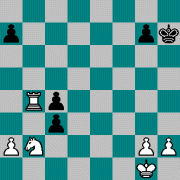 |
| Position after 4.Rb4 |
4...a5! The crux of the combination and, as Sanz later said, the most difficult move to find. Now Black cannot be stopped from queening. There are two ways in which White can play for a draw:
a) 5.Nxc4 c2 This happened in the game. Some sources say White resigned here, others that he resigned after a few more moves. There might follow: 6.Rb3 cl=Q+ 7.Kf2 Qxc4 etc., or:
b) 5.Rxc4 cxb2 followed by promotion with, in both cases, a Q vs. R endgame that Black can win without too much trouble.
But these endgames are not relevant because, as we shall see below, the 'Ortueta-Sanz' position as I gave it in the first diagram (which is the way it is almost always given) is a stylised version, probably invented to make sure Rxb2 is the only way to win.
Notwithstanding Rinck, Jan Timman, in New in Chess in 1997, has published a very beautiful study inspired by this combination.
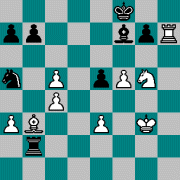 White to play and win. (See the diagram on the
left.) 1.f6 gxf6
The threat was 2.Rh8+ and
White to play and win. (See the diagram on the
left.) 1.f6 gxf6
The threat was 2.Rh8+ and
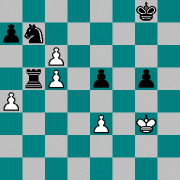 f7; on 1...Bg8 there follows 2.fxg7+ Ke7 3.Rh8 Rxb3 4.Rxg8 Kf6 5.Ne6 and
wins. 2.Rxf7+ Kg8 (Ke8 3.Ba4+) 3.Rxb7 Nxb7 (fxg5 4.Rxa7)
4.c6 Rxb3 5.c5 Rb5 6.a4 fxg5 (see the diagram on the right)
And now? 6.axb5
Nxc5 7.c7 Ne4+ 8.K- Nd6 and Black wins. 7.Kh3! A fantastic move.
White has the time to step out of a future check. Other moves fail to horizontal
Black checks, e.g.: 7.Kg4 Rxc5 8.cxb7 Rc4+ and Rb4. Or 7.Kf3 g4+ and White
is forced to go to a bad square. Now Black is lost: 7...g4+ 8.Kh4
and the white pawn promotes.
f7; on 1...Bg8 there follows 2.fxg7+ Ke7 3.Rh8 Rxb3 4.Rxg8 Kf6 5.Ne6 and
wins. 2.Rxf7+ Kg8 (Ke8 3.Ba4+) 3.Rxb7 Nxb7 (fxg5 4.Rxa7)
4.c6 Rxb3 5.c5 Rb5 6.a4 fxg5 (see the diagram on the right)
And now? 6.axb5
Nxc5 7.c7 Ne4+ 8.K- Nd6 and Black wins. 7.Kh3! A fantastic move.
White has the time to step out of a future check. Other moves fail to horizontal
Black checks, e.g.: 7.Kg4 Rxc5 8.cxb7 Rc4+ and Rb4. Or 7.Kf3 g4+ and White
is forced to go to a bad square. Now Black is lost: 7...g4+ 8.Kh4
and the white pawn promotes.
The whole game Ortueta - Sanz, the sixth in a play-off match for the
Championship of Castile (but Ortueta later said it was just a training
game), was first published in the February 1936 issue of the Spanish chess
magazine Ajedrez Español, annotated by Capablanca. A rather strange
publication at that; Capablanca gave extensive analysis and two diagrams
up to move 17, then seemed to lose interest, and treated the illustrious
combination almost with a shrug, and without a diagram.
Ortueta - Sanz, Championship of Castile (?), Madrid, 1933
1.e4 e6 2.d3 d5 3.Nc3 Nf6 4.e5 Nfd7 5.f4 Bb4 6.Bd2 O-O 7.Nf3 f6
8.d4 c5 9.Nb5 fxe5 10.dxe5 Rxf4 11.c3 Re4+ 12.Be2 Ba5 13.O-O Nxe5 14.Nxe5
Rxe5 15.Bf4 Rf5 16.Bd3 Rf6
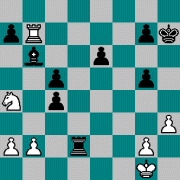
Ortueta - Sanz Position after 31.Na4 |
This is how the famous Ortueta-Sanz position really looks. 31...Rxb2 If because of the extra pawns, there are now other ways of winning, this is still the fastest. 32.Nxb2 c3 33.Rxb6 c4 34.Rb4 a5 35.Nxc4 Neither would 35.Rxc4 cxb2 36.a4 offer any chance here. 35...c2 and Black won in a few moves.
FAR LESS KNOWN than this combination, but at least as interesting, is the mystery of the duplication - or hoax - surrounding it.
Ever heard of Wojciechowski? Antoni Wojciechowski, who lived from 1905 to 1938, and who was many times champion of Poznan, his home town in Poland?
Tylkowski - Wojciechowski, Poznan City Championship, 1931
1.f4 d5 2.e3 c5 3.Nf3 Nc6 4.Bb5 Bg4 5.O-O e6 6.d3 Be7 7.Nc3 d4 8.Nb1
Nf6 9.e4 O-O 10.Bxc6 bxc6 11.c3 dxc3 12.Nxc3 Bxf3 13.Rxf3 Ng4 14.Kh1 Qd4
15.Qg1 Qxg1+ 16.Kxg1
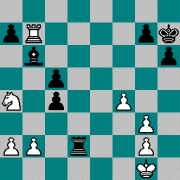
Tylkowski - Wojciechowski Poznan 1931 Position after 30.Na4 |
30...Rxb2 Exactly the same wonderful combination, in an almost identical position - but played 2 years earlier! 31.Nxb2 c3 32.Rxb6 c4 33.Rb4 a5 34.Nxc4 c2 Without support on the fourth rank, 34.Rxc4 cxb2 35.a4 b1=Q+ etc. is pointless. 35.Nxa5 c1Q+ 36.Kh2 Qc5 37.Rb2 (37.Ra4? Qh5+ and Qd1+, winning the rook, or 37.Rb3 Qxa5 38.a3? Qh5+ to the same effect, but after 37.Rb3 followed by Rf3, it is not entirely clear how Black will undo the fortress.) 37...Qxa5 38.g4 Qe1 39.g3 h5 40.gxh5 Kh6 and after 15 more moves, White resigned. The black King will now reach g4 and f3.
Antoni Wojciechowski belonged to the Polish top in the mid-thirties; one can find his name at board 8 of the Polish team that came second behind Hungary in the 'wild' Olympiad of Munich 1936. He won games against Spielmann, Najdorf and Przepiorka and drew with Rubinstein. 'But,' as his old chess friend from Poznan, Boleslaw Rozanski (a strong player in his own right; he played in the Polish Championship in 1954) later wrote: 'Wojciechowski was also a poor man with a weak health, and in January 1938 a bad attack of pneumonia killed him. His material circumstances played a part in this and unfortunately, before the war there was no money in our country to help big talents like him. He was an extremely talented player with an attacking style and a great gift for combination.'
When I first saw the Tylkowski - Wojciechowski position in Irving Chernev's
book 'Wonders and Curiosities of Chess' (1974), my initial thought was: mystification.
This was soothed when, through the well-known Polish chess journalist Litmanowicz,
I obtained the whole game. But when I traced the story in the Polish magazine
Szachy, I discovered that the Poles too, when the Wojciechowski position
appeared from out of the blue in the early fifties, had doubted its authenticity.
They still do, I found out when, in order to update
this story, I contacted my Polish friend, the chess writer and historian
Tomasz Lissowski. With his help, I can now give a more detailed publication
history of the mysterious Tylkowski - Wojciechowski position of the diagram
above.
In February 1952, Szachy published a short note
('Flashes from Poznan') from the
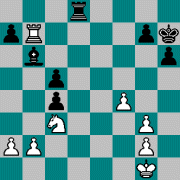
Position before Rd2 |
In April 1952, in a series 'Twins' in Szachy, Stanislaw Gawlikowski (top player, writer, endgame expert) did note the duplication. He expressed his doubt about the authenticity of the 'hitherto unknown (in Poland and internationally)' game Tylkowski - Wojciechowski which was 'similar as two drops of water to the famous ending of a match game Ortueta - Sanz, played in Madrid in 1933 which made the rounds in the chess world, and which can be found in many chess books.'
In August 1953, IM Makarczyk published, for the first time, the whole game in Szachy; chessplayers from Poznan had given him 'a duplicate of the game score Tylkowski - Wojciechowski from the Poznan championship in 1931'. He gave the moves as in the full gamescore above, and noted that the finish was different from the one originally given by Kwilecki.
Nevertheless, he believed Gawlikowski's doubts about the authenticity could be dropped, but still hoped that 'perhaps some local chess authorities could produce more details about this game, and whether it had previously been published.'
This was followed up in October 1953, again in Szachy, by Rozanski, who had been an eye witness to the game, and had seen Wojciechowski play his combination. 'I would like to state,' Rozanski wrote, 'that the authenticity of the game and the critical position can not be questioned. The splendid termination by Wojciechowski was, at the time, a sensation in Poznan chess circles, and the game was published in the chess column of the 'Dziennik Poznanski.' Rozanski had possessed a clipping of this column, but had lost it, along with his entire collection of chess literature, during the war. He named several other players from Poznan who had also witnessed the game.
Thus the story stood for a long time. And, when writing in 1985, I offered
a fortune to anybody who could show me a photocopy of that Dziennik Poznanski
column, that was 'not to assuage any doubt, but to pay homage to Wojciechowski.'
Well, this column may never have been published
at all.
As I said, when I turned to Tomasz Lissowski for
possible extra information, I discovered that the doubts remain in Poland.
In two books about chess in Poznan, one historical, the other more technical,
published in 1990 and 1991, there is no mention of Tylkowski - Wojciechowski.
Ironically, the author of these books, Andrzej Kwilecki, a Professor of
sociology in Poznan, is the same who first published the Tylkowski - Wojciechowski
position in Szachy in 1952.
At the time, Kwilecki had been given a handcopied
gamescore of the game by one Adam Miesowicz, an old Poznan acquaintance
of Wojciechowski's. (When Makarczyk later published the whole game for
the first time, he had also obtained it from Miesowicz.) Later however,
Kwilecki became convinced that this game had not, as Miesowicz stated,
been played in the 1931 Poznan championship but that, if it had been played
at all, it had been a friendly game, perhaps one in a private match. As
Miesowicz was no longer living when Kwilecki wrote his chess books, he
could not verify this with him. And he does not remember exactly what Miesowicz
showed him, almost half a century ago. It was certainly not the original
gamescore, nor an exact copy - photocopiers were not available to the public
then. It might have been a notation of the game, stopping at the combination,
and perhaps quoting the final moves wrongly - that would explain the discrepancy
between Kwilecki's and Makarczyk's versions of these final moves.
However that may be; as Kwilecki also never saw
a Dziennik Poznanski column with Tylkowski - Wojciechowski, he decided
the whole story was too dubious to include that game in his books.
But there is a difference between a scholar's need to prove a fact,
and an ordinary person's conviction that an unproven fact did nevertheless
happen. Personally, I am convinced the game Tylkowski - Wojciechowski was
played in Poznan in 1931 and that Wojciechowski played Rxb2, before Sanz
did.
About the witnesses, Miesowicz, Rozanski, and others,
Tomasz Lissowski wrote to me: 'All of them lived in Poznan all their life.
They always were recognized as serious, honest people, not infected by
some journalistical need for sensation. If, I repeat, if the game Tylkowski
- Wojciechowski was never played, if it was only a local myth, if it was
a corporate suggestion, it is for me quite clear that this suggestion was
extremely strong and the myth was born not in 1952, but years before.'
Shortly before his death in 1986, Rozanski wrote
to me: 'It is now more than 55 years ago, and who knew at the time that
this endgame - of rare beauty - would become a sensation in the chess world?
(...) The game was played in Poznan, the endgame made a great impression
on all spectators, we congratulated Wojciechowski, and that is everything.'
It is true: nobody who is alive now has seen that
mythical Dziennik Poznanski column. I still offer a fortune (a chess book
I wrote) to anyone who can show it to me, or any other pre-1934 publication
of Tylkowski-Wojciechowski. But even if a helpful person were to comb every
Poznan paper for every letter published from 1931 to 1934, and did not
find Rxb2, I still wouldn't think Tylkowski - Wojciechowski is a hoax.
It would only prove Rozanski, the only one who claimed to have seen the
column with the game, was mistaken about this detail. But he wouldn't be
the first honest person who genuinely believed to have seen something that
doesn't exist - and indeed: that column may very well lie buried somewhere
in an archive in Poznan. (PS 8 November 2006: But see entry 327 in my Open Chess Diary.)
There is another sort of argument that Tylkowski-Wojciechowski
must have been played. If it is a hoax, there must have been people who
invented the game. But who, why and how? Wojciechowski's old chess friends,
to honour him? Chess literature is full of fake games, most of them student's
jokes, or brilliant post-mortems brought to life. But I refuse to believe
anyone would go out stealing to achieve immortality for a friend who had
died tragically. And further: duplicating a combination is one thing, but
to compose a natural-looking game leading to a prescribed position is quite
another, even if some variation (on the King's side here) is allowed. I
tried to create a Rxb2 game of my own, but had to give up. Again, I offer
a book to the first reader who can show me a new and convincing game, ending
with the Rxb2 combination.
Finally: Tylkowski - Wojciechowski itself looks
like a perfectly natural chess game; no blunders to get the pieces where
they need to be. If there are a few moves that might seem funny, or that
I have trouble understanding - there are such moves in every chess game.
The famous combination Ortueta - Sanz, then, was a duplication of a
combination that had been played two years earlier in Poznan. Or, as the
endgame magazine EG phrased it, Tylkowski - Wojciechowski is 'the strangest
game-anticipation ever.'
Wojciechowski being first, what robbed him of the
immortality due to him? The answer is simple. There was a national Polish
chess magazine in those years, Przepiorka's Swiat Szachowy, but it had
only a few pages per month, and never reported on local events. If Wojciechowski's
beautiful combination was published at all, it was in an obscure local
chess column which, for twenty years, remained the only place where it
could have been found.
Sanz played Rxb2 two years later, but he was luckier.
His stroke of genius must have been noted soon - the combination appeared
in the August 1934 issue of the Belgian magazine L'Echiquier (annotated
by Tartakower with the caption 'Les pions acrobatiques') and almost at
the same time in the August-September 1934 issue of the national Romanian
chess magazine. In his February 1936 publication in Ajedrez Español,
Capablanca said that Sanz' combination was 'already becoming known throughout
the entire world' - indeed, reaching the young Tigran Petrosyan in Tiflis
in 1939.
One wonders if Wojciechowski too, could have seen
it, in the short years he had yet to live. If it reached Tiflis by 1939...
Edward Winter gave me the interesting information that the position was
in the December 1934 issue of the Wiener Schachzeitung, special attention
drawn to it as 'the most beautiful end-game of the year.' Poznan (Posen)
had a strong German minority. Maybe there were subscribers there. Imagine
a chess friend approaching Wojciechowski at the club, magazine in hand:
'Look Antoni, you played that a few years ago, didn't you? Somebody stole
your combination!'
Maybe he would just have shrugged his shoulders.
Maybe the true miracle is that the Rxb2 combination
has only happened twice. When I sent the Tylkowski - Wojciechowski game
and position to the endgame composer and connoisseur Harold Lommer, who
had published extensively about Ortueta - Sanz and had even travelled to
Madrid to interview Sanz about it, all he had to say was: 'Fine game, but
there are so many wonderful games that never see the light of day.'
Or did it only happen once - but in Poland? When
Ortueta died in 1994 (at 92), the respected Spanish chess writer Pablo
Morán published an obituary in which he wondered if Ortueta - Sanz
couldn't be a fake.
Antoni Wojciechowski (1905 - 1938) in 1936 (Taken from a photograph of the Polish team.) |
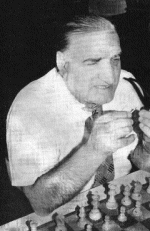
Jose Sanz Aguado (1906 - 1969) in 1963 |
With many thanks to Tomasz Lissowski for his invaluable help. And with thanks to Edward Winter for his information on the 1934 publications.